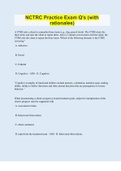NCTRC Practice Exam Q's (with rationales) A CTRS asks a client to remember three items (e.g., dog, pencil, book). The CTRS states the three items and asks the client to repeat them. After a 5 -minute conversation with the client, the CTRS asks the client to repeat the three items. Which of the foll owing domains is the CTRS assessing? A. Affective B. Social C. Cultural D. Cognitive - ANS - D. Cognitive "Cognitive examples of functional abilities include memory, orientation, attention span, reading ability, ability to follow directions and other mental functions that are prerequisites to leisure behavior." When documenting a client's progress toward treatment goals, subjective interpretation of the client's progress must be supported with A. assessment of data B. behavioral observations C. client comments D. input from the treatment team - ANS - B. behavioral observations "In all cases, documentation and written records should focus on client behavior, rather than the specialist's perceptions or guesse s. In each case, the specialist is responsible for selecting the most significant aspects of client behavior for documentation." A CTRS would use interventions such as yoga, deep breathing, and meditation with clients who need to improve A. stress manage ment skills B. physical conditioning C. awareness of their emotional state D. mindful self -awareness - ANS - A. stress management skills "Relaxation techniques are a means to deal with excess tension brought about by stress. In the section that follows, several methods for eliciting a state of relaxation are described. Covered are deep breathing, progressive relaxation training, autogenic training, imagery, meditation, yoga, laughter yoga, biofeedback, massage, stretching, and physical exercise." All of the following are techniques used in behavior management programs EXCEPT A. cognitive restructuring B. backward chaining C. aversion therapy D. resocialization - ANS - D. resocialization "Table 3.6 Overview of Specific Behavior Management Techniques: Aversion therapy: developing an aversion to a stimulus by pairing that stimulus with vividly imagined noxious stimuli, Cognitive restructuring: changing maladaptive behavior by demonstrating t he irrationality of the assumptions on which the behavior is based and teaching the person more adaptive self -talk, Backward chaining: instruction starts with the last step in a sequence and when the client has acquired the last step, the next to last step is taught and so on until the first task in the chain is accomplished." All of the following are appropriate behavioral objectives for therapeutic recreation EXCEPT A. Upon request, the client will select two personal activity choices from a list of opt ions. B. Upon request, the client will verbalize the appropriate use of five resources, as judged by the CTRS. C. Upon request, the client will demonstrate knowledge of the leisure planning process by being active on weekends. D. Upon request, the client will be able to drive a golf ball a minimum of 100 yards on three out of five attempts. - ANS - C. Upon request, the client will demonstrate knowledge of the leisure planning process by being active on weekends. "Once again, the agency will dictat e the format used for client objectives. However, the most common type of objective is the behavioral objective. Because behavioral objectives translate into client outcomes, some extended discussion is needed on their development and format. Behavioral ob jectives are usually very specific and contain a condition, behavior, and criterion." Which of the following does the criterion part of a behavioral objective identify? A. The circumstance under which the behavior will occur B. The indication that the objective has been achieved C. The action taken to demonstrate the behavior D. The objective behavior that will be observed - ANS - B. The indication that the objective has been achieved "The criterion in the behavioral objective delineates the ex act amounts and nature of the behavior that can be taken as evidence that the objective has been met. A criterion is a precise statement or standard that allows individuals to make judgments based on the observable, measurable behavior." A 67 year old cli ent was admitted to a rehabilitation center with a diagnosis of a cerebrovascular accident (CVA) that affected her right side and speech. The client is a retired executive who had played golf and bridge several times a week. She is now able to walk 200 fee t with a cane. She also has good receptive skills. Which of the following are the MOST appropriate factors to assess prior to the client's resumption of golf? A. Balance, coordination, and endurance B. Auditory deficits, upper extremity range of motion , and health history C. Grip strength, forearm strength, and verbal expression D. Attention span, verbal expression, and cognitive sequencing - ANS - A. Balance, coordination, and endurance "Client assessment involves measurement of client needs, limitations, and abilities in order to place that client in the most logical programs that are designed to address those needs, limitations, and abilities." "The initial interventions TRSs prescribe focus on improving strength, endurance and ROM; adjusting to visual neglect; and preventing contractures and spasticity." Focus charting is used when the treatment team wants to A. show similarities and differences between clients B. use a critical ca re map of client progress C. follow the diagnostic protocol




